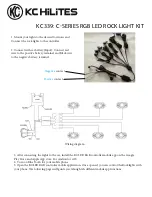
Service Forward Collision Warning
(FCW) Light — If Equipped
This warning light will illuminate to indicate a
fault in the Forward Collision Warning Sys-
tem. Contact an authorized dealer for ser-
vice
Service Stop/Start System Warning
Light — If Equipped
This warning light will illuminate when the
Stop/Start system is not functioning properly
and service is required. Contact an autho-
rized dealer for service.
Cruise Control Fault Warning Light
This warning light will illuminate to indicate
the Cruise Control system is not functioning
properly and service is required. Contact an
authorized dealer.
Sway Bar Fault Warning Light
This light will illuminate when there is a fault
in the sway bar disconnect system
Tire Pressure Monitoring System (TPMS)
Warning Light
The warning light switches on and a mes-
sage is displayed to indicate that the tire
pressure is lower than the recommended
value and/or that slow pressure loss is
occurring. In these cases, optimal tire duration and fuel
consumption may not be guaranteed.
Should one or more tires be in the condition previously
mentioned, the display will show the indications corre-
sponding to each tire.
CAUTION!
Do not continue driving with one or more flat tires as
handling may be compromised. Stop the vehicle,
avoiding sharp braking and steering. If a tire puncture
occurs, repair immediately using the dedicated tire
repair kit and contact an authorized dealer as soon
as possible.
Each tire, including the spare (if provided), should be
checked monthly when cold and inflated to the inflation
pressure recommended by the vehicle manufacturer on
the vehicle placard or tire inflation pressure label. If
your vehicle has tires of a different size than the size
indicated on the vehicle placard or tire inflation pres-
sure label, you should determine the proper tire infla-
tion pressure for those tires.
As an added safety feature, your vehicle has been
equipped with a TPMS that illuminates a low tire pres-
sure telltale when one or more of your tires is signifi-
cantly underinflated. Accordingly, when the low tire
pressure telltale illuminates, you should stop and check
your tires as soon as possible, and inflate them to the
proper pressure. Driving on a significantly under
inflated tire causes the tire to overheat and can lead to
tire failure. Underinflation also reduces fuel efficiency
and tire tread life, and may affect the vehicle’s handling
and stopping ability.
Please note that the TPMS is not a substitute for proper
tire maintenance, and it is the driver’s responsibility to
maintain correct tire pressure, even if underinflation
has not reached the level to trigger illumination of the
TPMS low tire pressure telltale.
Your vehicle has also been equipped with a TPMS mal-
function indicator to indicate when the system is not
operating properly. The TPMS malfunction indicator is
combined with the low tire pressure telltale. When the
system detects a malfunction, the telltale will flash for
approximately one minute and then remain continu-
ously illuminated. This sequence will continue upon
subsequent vehicle start-ups as long as the malfunc-
tion exists. When the malfunction indicator is illumi-
nated, the system may not be able to detect or signal
low tire pressure as intended. TPMS malfunctions may
occur for a variety of reasons, including the installation
of replacement or alternate tires or wheels on the
vehicle that prevent the TPMS from functioning prop-
erly. Always check the TPMS malfunction telltale after
replacing one or more tires or wheels on your vehicle to
ensure that the replacement or alternate tires and
wheels allow the TPMS to continue to function properly.
CAUTION!
The TPMS has been optimized for the original equip-
ment tires and wheels. TPMS pressures and warning
have been established for the tire size equipped on
your vehicle. Undesirable system operation or sensor
damage may result when using replacement equip-
ment that is not of the same size, type, and/or style.
Aftermarket wheels can cause sensor damage. Using
aftermarket tire sealants may cause the Tire Pressure
Monitoring System (TPMS) sensor to become inoper-
able. After using an aftermarket tire sealant it is rec-
ommended that you take your vehicle to an autho-
rized dealer to have your sensor function checked.
138
GETTING TO KNOW YOUR INSTRUMENT PANEL
5538906_24_JL_OM_EN_USC_t_E1.pdf 138
5/22/2023 9:02:22 AM
















































